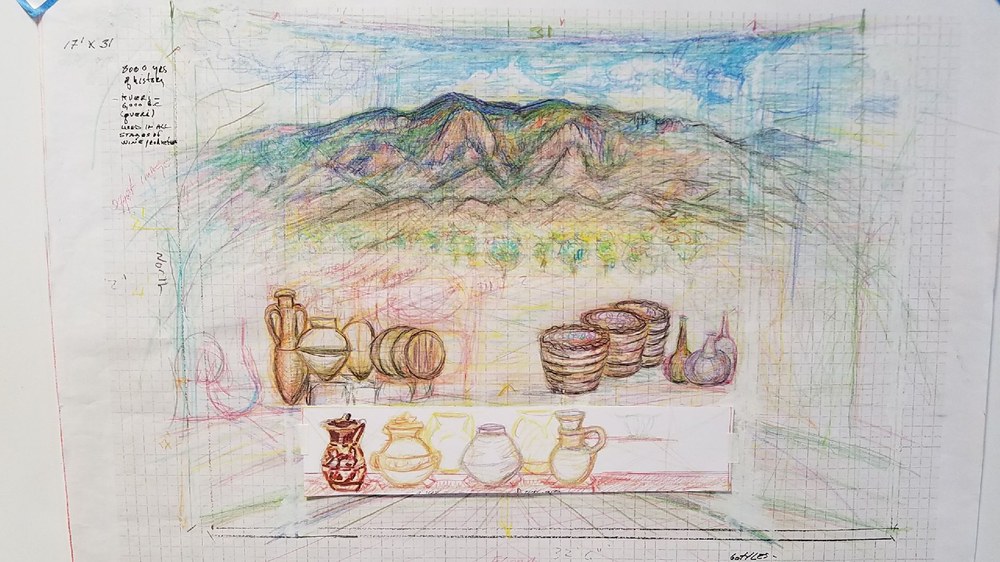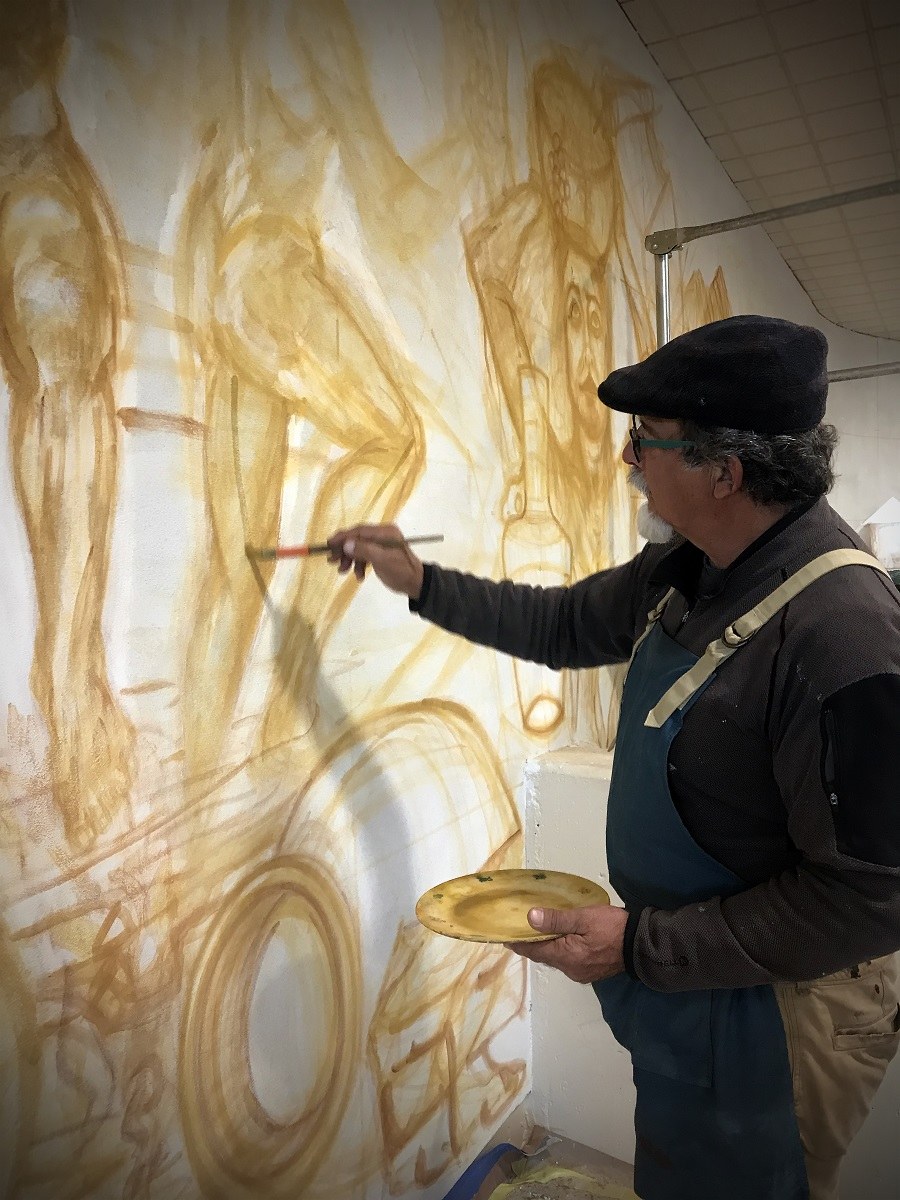Albuquerque Convention Center Fresco
The Albuquerque Convention Center Fresco project.

The Art of Fresco
The Ancient Art of Fresco is one of the oldest and noble of the painting techniques. Fresco is an Italian Word applied to the process of painting on fresh lime plaster. The name is derived from the method of coloring “wet” or “fresh” (Buon fresco) plaster. When the plaster dries, upon using inorganic pigments the chemical process of recreating calcium carbonate (limestone, a rock with color) the painting then becomes a part of the wall. These technique is much more durable than simply painting on the surface of a wall.
The fresco process has been used by many cultures throughout history. Modern materials continue to refine an ancient art form. The earliest frescoes of a highly developed nature technically, are those of the late Minoan period excavated at Knossos on the Greek island of Crete. These frescoes are dated at 1600-1500 BC and still have retained their rich colors.
Project Background
The City of Albuquerque Public Art Program has commissioned a 2500+ square foot fresco in the Albuquerque Convention Center by renowned New Mexico artist, Frederico Vigil. The Public Art Program has committed to funding the entire fresco, a documentary and an interactive digital media installation about the fresco process and theme - all over the course of nearly 4 years. The fresco project kicked off in late November 2017 and is still in process.
Theme of the Albuquerque Convention Center Fresco Project
The Fresco will encase the circular stairwell walls as well as portions of the stairwell ceiling and center support walls with 6-7 distinct scenes illustrating various forms of New Mexico Landscape, agricultural techniques, winemaking processes, plant physiology and cosmic mythologies. The historical origins of wine in North America began in New Mexico, and this important event is the primary theme that runs throughout the fresco design. Vignettes of planting techniques, irrigation, cultivation, harvest and processing practices will convey the rich history of winemaking in New Mexico and the world.
Wine New Mexico, the wine makers trade association has graciously agreed to host education- al wine events during the fresco creation showcasing the varietals and fermentation techniques employed by professional grape growers and vintners to enhance the knowledge about the fresco theme.
Materials
Plaster - A slaked lime and sand mixtures
Cement - Pure white cement is used only on the first plaster coat.
Colors - Lime-proof powdered pigments are used. The basic colors available are: Vine Black, Yellow Ochre, Raw Sienna, Burnt Sienna Cobalt Blue, Viridian Green, Puzzuoli Red, Red Ochre, Golden Ochre, and Ultra Marine blue.
The Process
The plastering consists of five layers of lime/sand mixtures. The object of the plastering is to obtain a normally porous surface, which will hold much water. Lime, quicklime, or burnt lime have been used as a plaster and mortar by most civilizations. The lime must be slaked, mixed with water, in order for the chemical reaction converting Calcium Oxide (CaO) into Calcium Hydroxide (Ca (OH) 2) to take place. The function of the sand is to strengthen the plaster by eliminating shrinkage during drying. Coarse, medium, and fine sand are used. The first three plaster layers must be set a minimum of ten days prior to the final coats. The painting is made on the forth and on the fifth layer of plaster which is called the intonaco surface.
Sketches drawn to scale of the entire Compositions are made in full color. These plans are enlarged to the actual size of the painting area in the Sinopia stage. The drawings are transferred on to tracing paper, and these are called “Cartones”.
Prior to painting, the cartoon outline is perforated and transferred on to the intonaco (pouncing stage) and the day’s painting begins.
The artist must apply the paint before the plaster dries, only a section (giornata) of the composition may be worked from start to finish in a day. The painter must master the technique of joining each day’s intonaco, in order for the completed fresco to appear as a continuous painting without visible joints.
Colors or outlines once laid on can only be changed by removing the forth and intona- co surfaces affected (back to the Sinopia stage) and plastering, then painting the work again. The final chemical reaction is: Ca (OH)2+CO2>CaCO3+H2O= Calcium Carbon- ate- limestone, marble.
About the Artist: Frederico Vigil

Vigil is one of only a handful of master Fresco artists in the southwest specializing in the ancient art of buon Fresco. Vigil has completed frescos throughout New Mexico, California, Santa Fe de La Vega, Granada, and in Alburquerque and Extremadura, Spain. His smaller scale, two-dimensional works have been exhibited throughout the United States and Spain, with a set of his “cartones” were recently displayed in Apex Gallery in Rapid City, S.D.
This Fresco project provides a unique opportunity for high school and college interns and apprentices to work and learn alongside Mr. Vigil learning the fine art of Fresco, an art form that has endured centuries and continues forward with improved techniques and unprecedented public locations. These apprentices will put in hours of time and labor learning this art medium.
